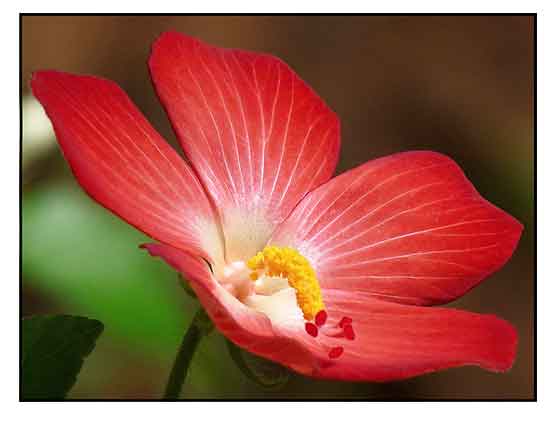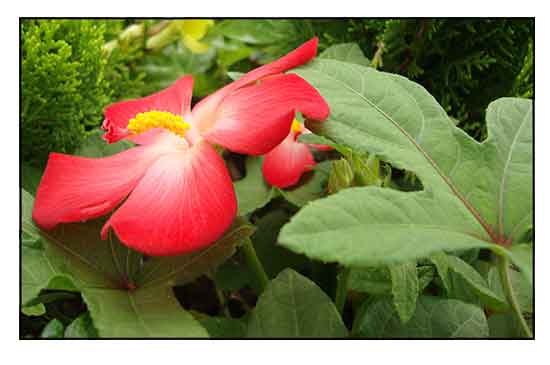 Gen info Gen info
- Abelmoschus is a genus of annual, biennial or perennial malvaceous herbs in the subfamily Malvoidae and family Malvaceae. It is the segregate of Hibiscus, and distinguished by the possession of a deciduous cicumscissile spathaceous calyx. (2)
- Abelmoschus sagittifolius is often classified as a subspecies (tubrosus) of Abelmoschus moschatus. However it has a different karyotype (2n=36 versus 2n=72), and therefore, it is a separate species. (2)
-
Etymology: The genus name Abelmoschus is Neo-Latin from Arabic "abu l-misk" meaning "father of musk", or "jabb-el-misk", meaning musk seed, alluding to its scented seeds. (3) The species epithet sagittifolius derives from Latin, sagitta meaning "arrow" and folium meaning "leaf", perhaps, referreing to arrow-shaped leaves.
- The word okra first appeared in 1679 in the Colony of Virginia, derived from the igbo word okuru. The word gumbo first appeared in American vernacular around 1805, deriving from Louisiana Creole, but originating from either Umbundo word ochinggombo or Kimbundu word ki-ngombo. In most of the U.S., the word gumbo refers to the dish gumbo, but for many in the Deep South the word refers to the pods and plants. (3)
 Botany Botany
Abelmoschus sagittifolius is a perennial herb, 0.4-1(-2) m tall, most parts densely pubescent, sometimes also setose or stellate hairy; rootstock fleshy, radish-shaped, to 5 cm thick. Branchlets scabrous and hirsute with long hairs. Petiole 4-8 cm, sparsely long hirsute; leaf blades variable; blades on proximal part of stem ovate, those on middle and distal parts ovate-hastate, sagittate, or palmately 3-5-lobed or -parted, lobes broadly ovate or broadly lanceolate, 3-10 cm, abaxially long hirsute, adaxially sparsely spiny, base cordate or hastate, margin serrate or lobed, apex obtuse. Flowers solitary, axillary. Pedicel slender, 4-7 cm, densely scabrous hirsute. Epicalyx lobes 6-12, filiform, ca. 15 × 1-1.7 mm, sparsely hirsute, spreading or reflexed. Calyx spatulate, ca. 7 mm, apex 5-toothed, densely minutely puberulent. Corolla mostly white or pale yellow to dark pink, 4-5 cm in diam.; petals obovate-oblong, 3-4 cm. Staminal column ca. 2 cm, glabrous. Style branches 5; stigma flat. Capsule ellipsoid, ca. 3 × 2 cm, spiny, shortly beaked. Seeds reniform, glandularly reticulately striate. (Flora of China)
Distribution
- Native to the Philippines.
- Also native to Cambodia, China, Hainan, India, Jawa, Laos, Malaya, Myanmar, New Guinea, Queensland, Thailand, Vietnam.
- Ornamental cultivation.
 Constituents Constituents
- Study of stem tuber isolated a new sesquiterpenoid quinone, Acyl hibiscone B (1), together with five known compounds, (R)-lasiodiplodin (2), (R)-de-O-methyllasiodiplodin, (3) dibutyl phthalate (4), (R)-9-phenylnonan-2-ol (5) and hibiscone B (6). (see study below) (6)
- Study of stem bark yielded a new cadinane sesquiterpenoid glucoside, 2β,7,3-trihydroxycalamenene 3-O-β-d-glucoside (1) together with six known compounds, N-(p-trans-coumaroyl)-N-methyl tyramine (2), Cleomiscosin A (3), 9,12,13-trihydroxy-10,15-heptadecadienoic acid (4), Cytochalasin B (5), Marmesinin (6) and N-(p-trans-coumaroyl) tyramine (7). (see study below) (7)
- Study of aerial parts isolated six compounds: sitostenone (1), friedelin (2), vomifoliol (3), vanilic acid (4), ketopinoresinol (5) and daucosterol (6).
(9)
- Nutrient analysis of rhizome
yielded: moisture 14.97% (comparable with leguminous crops), crude protein 9.22% (higher than maize, lower than common crops), soluble protein 2.04%. Total amino acids were 6.18% and 1.45% in hydrolysis samples and free samples; essential amino acids and semi-essential amino acids accounting for 28.93% and 13.45% of total amino acids, respectively. Crude fat content was 17.57%, saturated fatty acids 33.16% of total fatty acids, of which 27.20% was palmitic acid and 5.96% stearic acids. Total sugar content was 55.75%, soluble sugar content 4.41%, reducing sugar content 2.08%, crude fiber content 4.35%. Mineral contents (mg/100g) were calcium 399.60, iron 12.32, zinc 5.35, manganese 1.40, 1.15, potassium 341.43, and magnesium 129.78.
(10)
Properties
- It has a deep tap root and can be grown in containers deep enough to accommodate the roots.
-
Studies have shown antioxidant, cytotoxicity, anticancer properties.
Parts used
Roots, stems, leaves.
Uses
Edibility
- Leaves, roots, stems and flowers used for making tea.
Folkloric
- No reported folkloric medicinal use in the Philippines.
-
In Vietnamese and Chinese traditional medicine, root tuber is used for treatment of cough, tuberculosis, constipation, neurasthenia, abscess, backache, headache, stomach aches, phthisis, carbuncles, dizziness, and lumbosacral pain. (5)
- Poultice of leaves and flowers used to treat scabies.
- In China, Maonan people drink decoction of ground roots for treatment of furuncles. (8)
- Root tubers used for treatment of cough, constipation, neurasthenia, malnutrition, boils, back pain, dizziness, and stomach pain. (9)
Studies
• Abelsaginol / Antioxidant Sesquiterpene: Study isolated a sesquiterpenoid compound, abelsaginol (AS). The antioxidant activity was evaluated both theoretically and experimentally. AS was shown to have ABTS scavenging activity two times lower t(IC50 41.04 mM) than Trolox (IC50 25.16 mM). Compared with natural typical antioxidants, the activity of AS in water at pH 7.40 is generally higher than Trolox or BHT. AS is a promising natural antioxidant in an aqueous physiological environment. (5)
• Cytotoxicity Against Human Cancer Cell Lines / Sesquiterpenoid Quinone / Stem Tuber: Study of stem tuber isolated a new sesquiterpenoid quinone, Acyl hibiscone B (1), together with five known compounds. Compound 1 showed significant cytotoxicity against Hela and HepG-2 human cancer cell lines. (see constituents above) (6)
• Cytotoxicity / Stem Bark: Study of stem bark yielded a new cadinane sesquiterpenoid glucoside, 2β,7,3-trihydroxycalamenene 3-O-β-d-glucoside (1) together with six known compounds, N-(p-trans-coumaroyl)-N-methyl tyramine (2), Cleomiscosin A (3), 9,12,13-trihydroxy-10,15-heptadecadienoic acid (4), Cytochalasin B (5), Marmesinin (6) and N-(p-trans-coumaroyl) tyramine (7). Compounds 1-7 showed moderate cytotoxicity against Hela and HepG-2 human cancer cell lines. (7)
Availability
- Wild-crafted.
- Ornamental cultivation.
- Seeds in the cybermarket.
|

![]()






